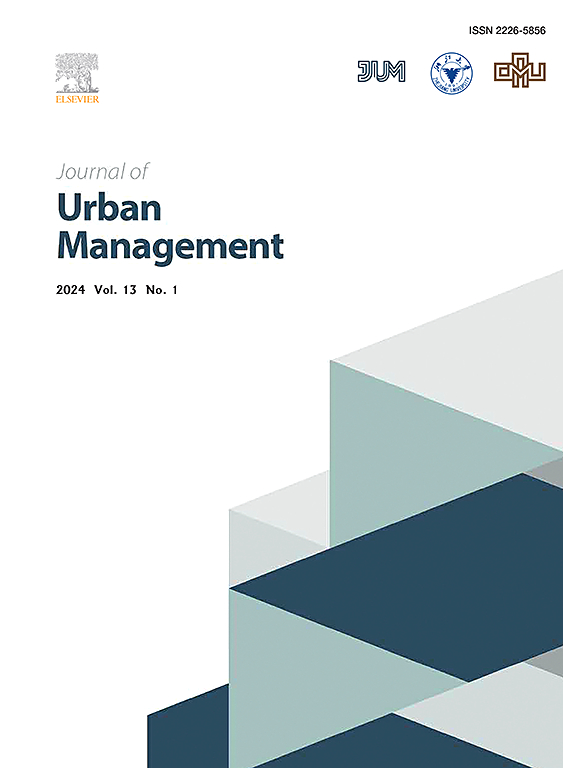利用机器学习和地质统计学方法评估孟加拉国主要城市单元的城市扩张敏感性
IF 5
2区 社会学
Q1 URBAN STUDIES
引用次数: 0
摘要
本研究考察了孟加拉国主要城市地区城市扩张的控制因素和易感区,包括达卡、巴里萨尔、吉大港、科米拉、纳拉扬甘杰、加济布尔、库尔纳、锡尔赫特、拉杰沙希、兰格布尔和迈门辛格。本研究的主要目标是利用数据驱动的方法确定控制因素的影响,并确定主要城市单位的城市扩张易感区。利用DEM、坡度、LST、NDVI、人口、距离(工业、增长中心、聚落、设施、水体、道路)、机器学习(随机森林)和地统计学方法(二元Logistic回归)等控制因子,识别出影响城市扩张的最重要因素,包括NDVI、LST、水体、道路和聚落。RF模型的ROC-AOC值在Comilla和Mymensingh地区精度最高(1.00),在Barisal、吉大港、Narayanganj、Gazipur、Khulna和Rajshahi地区精度中等(0.99),在Dhaka(0.98)、Sylhet(0.89)和Rangpur(0.85)地区精度较低。在二元Logistic回归模型中,Comilla、Narayanganj、Gazipur和Mymensingh的拟合最佳(Nagelkerke R2 = 1.00), Sylhet的显著性最低(0.482)。其中,主要城市单元库尔纳的城市扩张敏感性最高,为35.72%。Rajshahi和Barisal为中等和低城市扩张敏感性,分别为83.17%和0.88%。这个未经规划的快速城市扩张区也给政策制定者和规划者带来了难以克服的挑战,并强调了地方政府管理和利用地理空间数据的稀缺土地资源的能力。因此,本研究的机器学习和地质统计学发现将有助于解释孟加拉国11个大都市区的土地覆盖变化和城市扩张。本研究将提高对孟加拉国城市发展的认识。研究结果将有助于规划者、利益相关者和决策者了解城市扩张模式,从而实现更好的环境规划。本文章由计算机程序翻译,如有差异,请以英文原文为准。
Assessment of urban expansion susceptibility in major urban units of Bangladesh leveraging machine learning and geostatistical approach
This study examines the governing factors and susceptibility zones for urban expansion in Bangladesh's major urban areas, including Dhaka, Barisal, Chittagong, Comilla, Narayanganj, Gazipur, Khulna, Sylhet, Rajshahi, Rangpur, and Mymensingh. The main goals of this research are to determine the impact of governing factors and to identify susceptibility zones for urban expansion in major urban units using a data-driven approach. By using governing factors (DEM, Slope, LST, NDVI, Population, distance to (industry, growth center, settlement, facilities, waterbody, road), and machine learning (Random Forest) and geostatistical approach (Binary Logistic Regression), the research identifies the most important factors influencing urban expansion, including NDVI, LST, waterbodies, roads, and settlements. The RF model's ROC-AOC values showed the highest accuracy (1.00) in Comilla and Mymensingh, moderate accuracy (0.99) in Barisal, Chittagong, Narayanganj, Gazipur, Khulna, and Rajshahi, and lower accuracy in Dhaka (0.98), Sylhet (0.89), and Rangpur (0.85). For the Binary Logistic Regression model, Comilla, Narayanganj, Gazipur, and Mymensingh had the best fit (Nagelkerke R2 = 1.00), while Sylhet had the lowest significance (0.482). Furthermore, Khulna, a major urban unit, is the highest urban expansion susceptibility zone which is 35.72%. Rajshahi and Barisal are the moderate and low urban expansion susceptibility where 83.17% and 0.88% respectively. This unplanned and rapid urban expansion zone has also confronted policymakers and planners with an insurmountable challenge and stressed local governments' ability to manage and use their scarce land-based resources with geospatial data. Thus, this study's machine learning and geostatistical findings will help explain land cover change and urban expansion in Bangladesh's eleven metropolitan areas. This study will improve urban development understanding in Bangladesh. Findings will help planners, stakeholders, and policymakers understand urban expansion patterns, enabling better environmental planning.
求助全文
通过发布文献求助,成功后即可免费获取论文全文。
去求助
来源期刊

Journal of Urban Management
URBAN STUDIES-
CiteScore
9.50
自引率
4.90%
发文量
45
审稿时长
65 days
期刊介绍:
Journal of Urban Management (JUM) is the Official Journal of Zhejiang University and the Chinese Association of Urban Management, an international, peer-reviewed open access journal covering planning, administering, regulating, and governing urban complexity.
JUM has its two-fold aims set to integrate the studies across fields in urban planning and management, as well as to provide a more holistic perspective on problem solving.
1) Explore innovative management skills for taming thorny problems that arise with global urbanization
2) Provide a platform to deal with urban affairs whose solutions must be looked at from an interdisciplinary perspective.
 求助内容:
求助内容: 应助结果提醒方式:
应助结果提醒方式:


